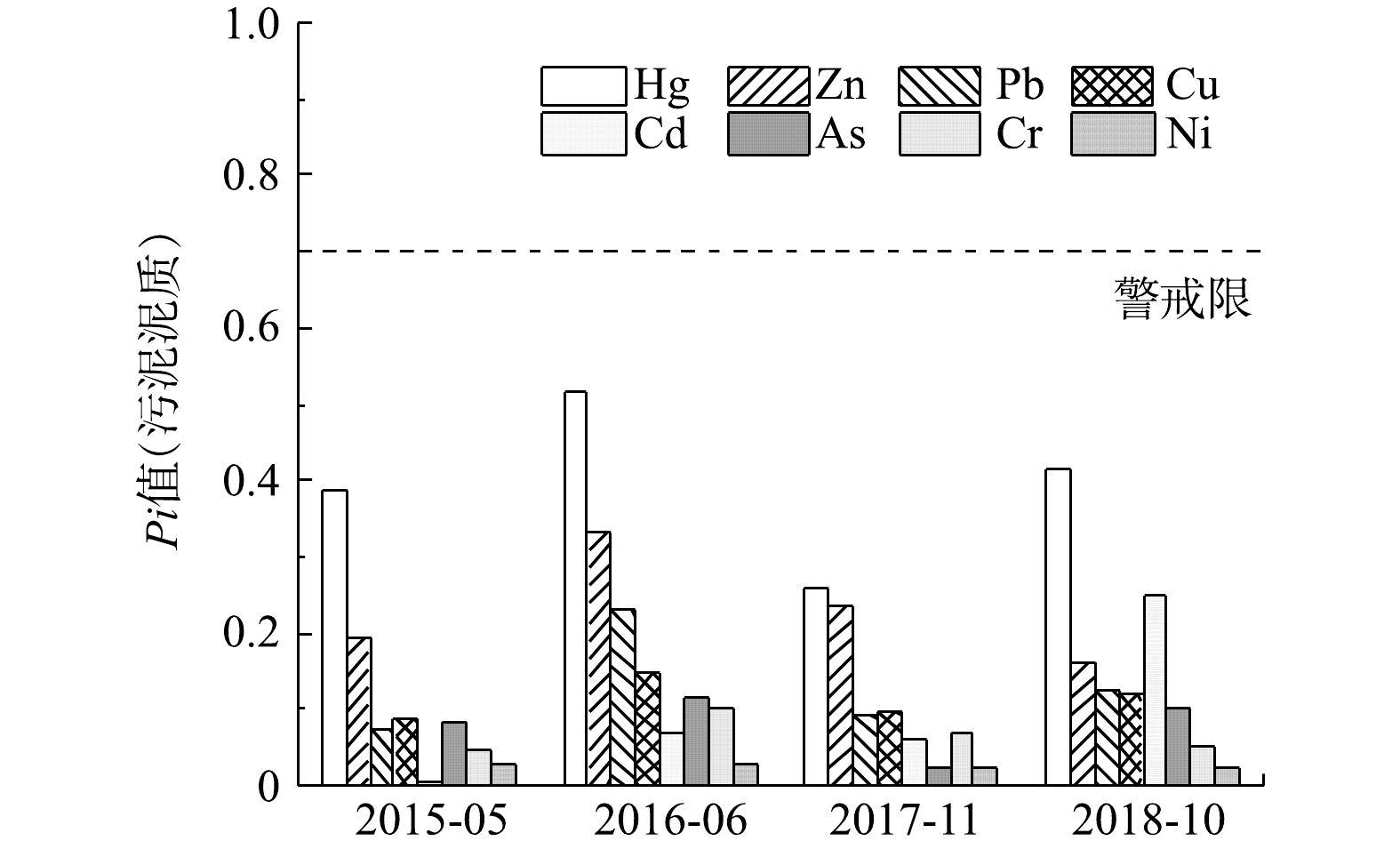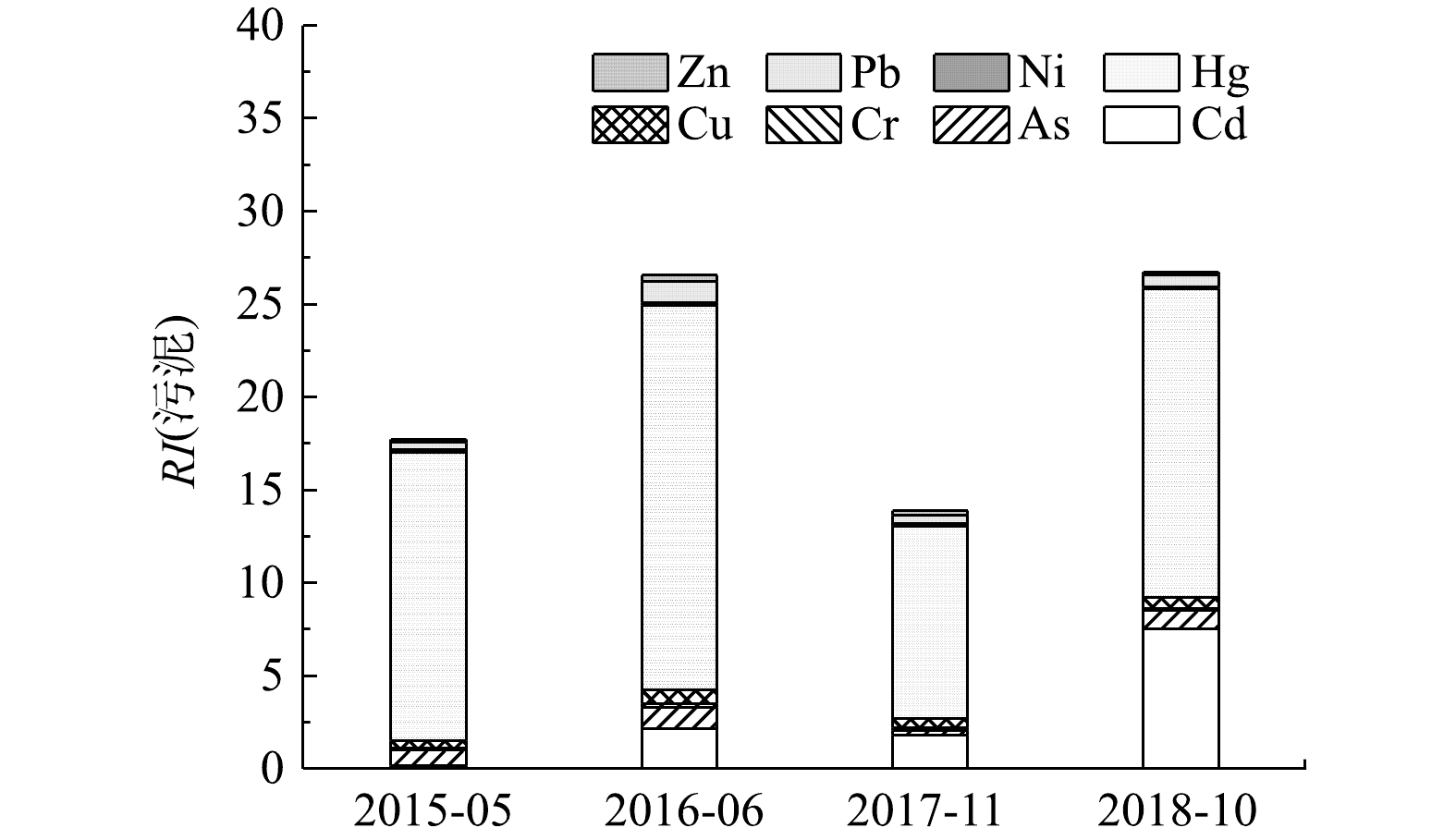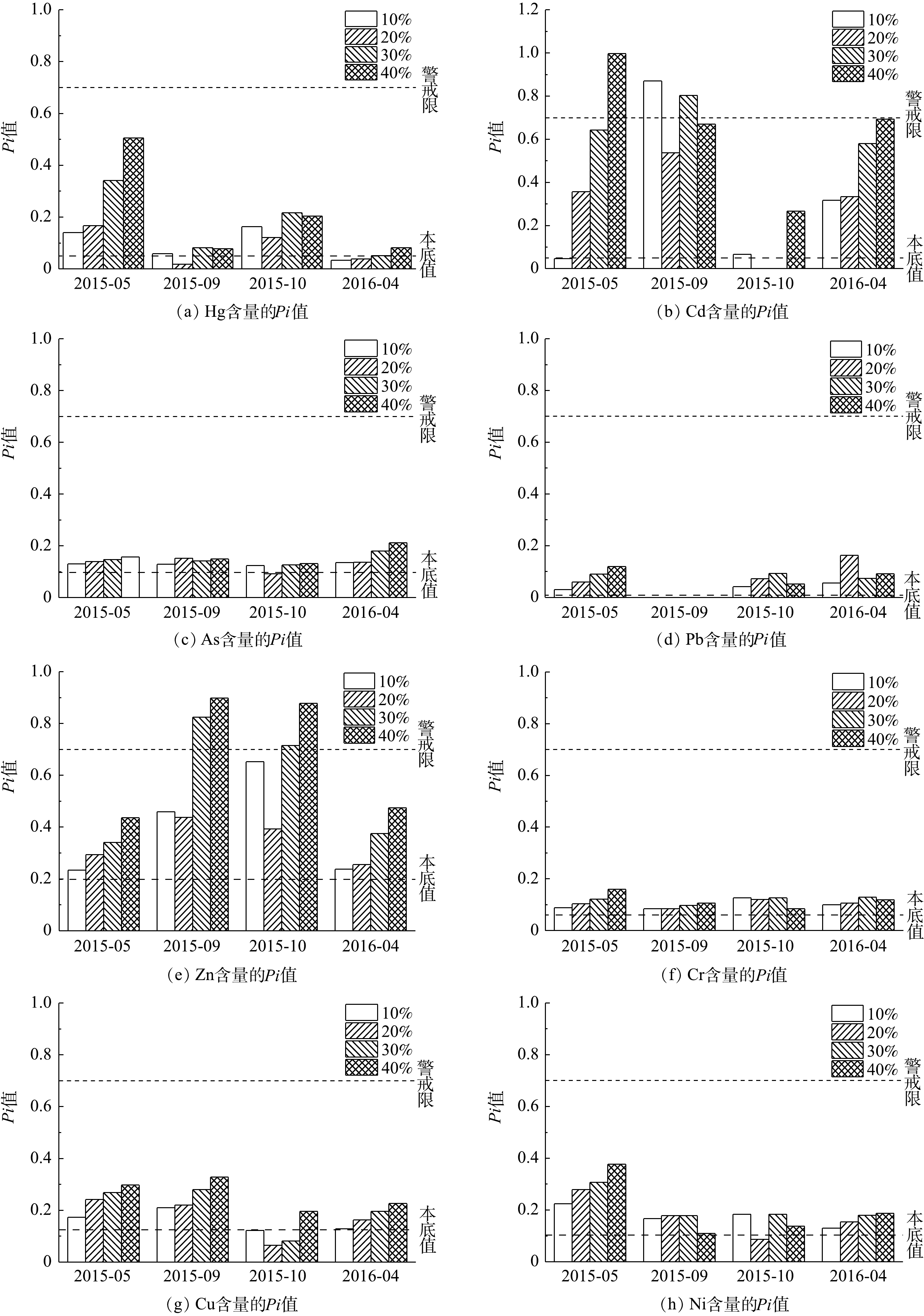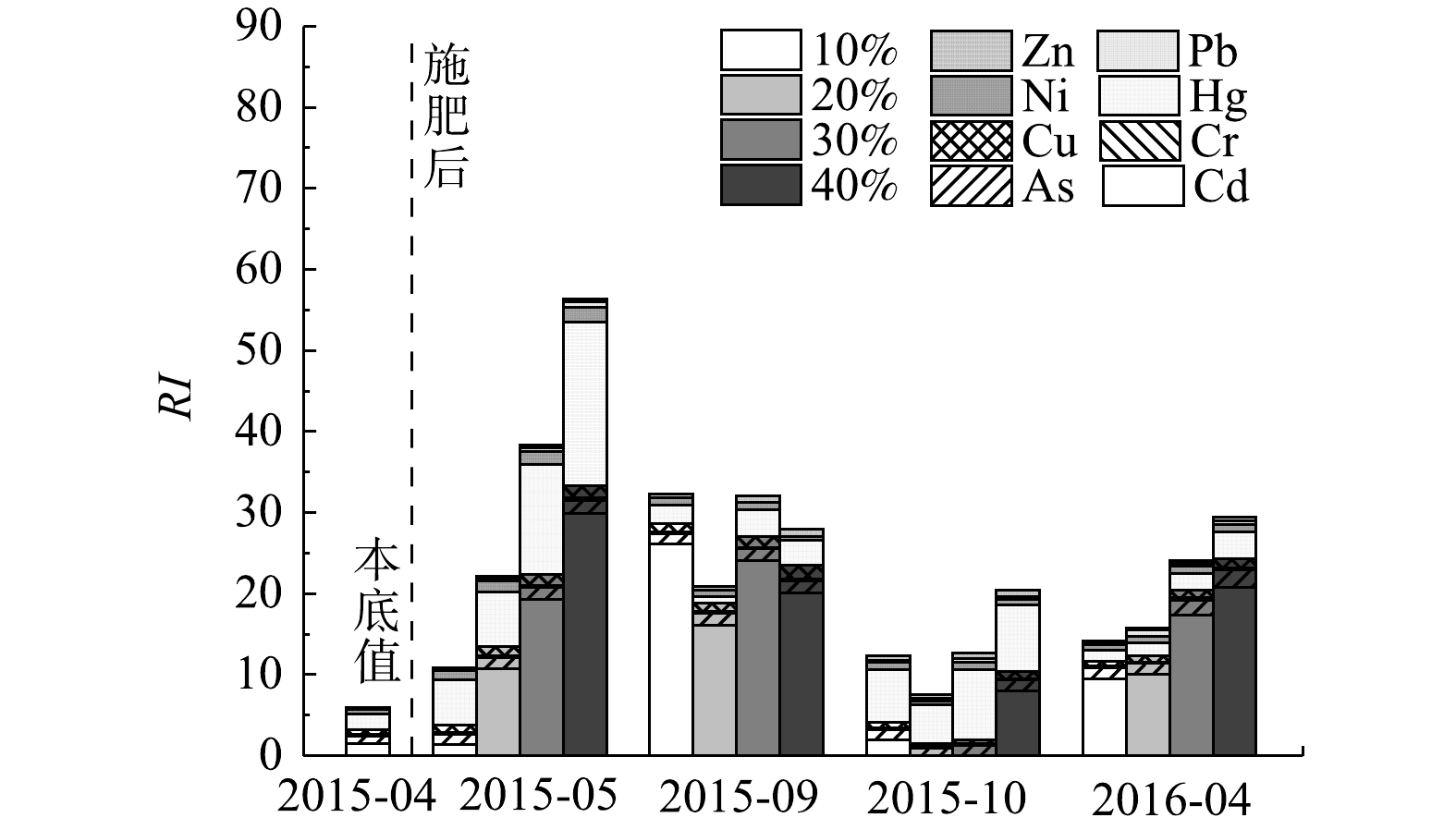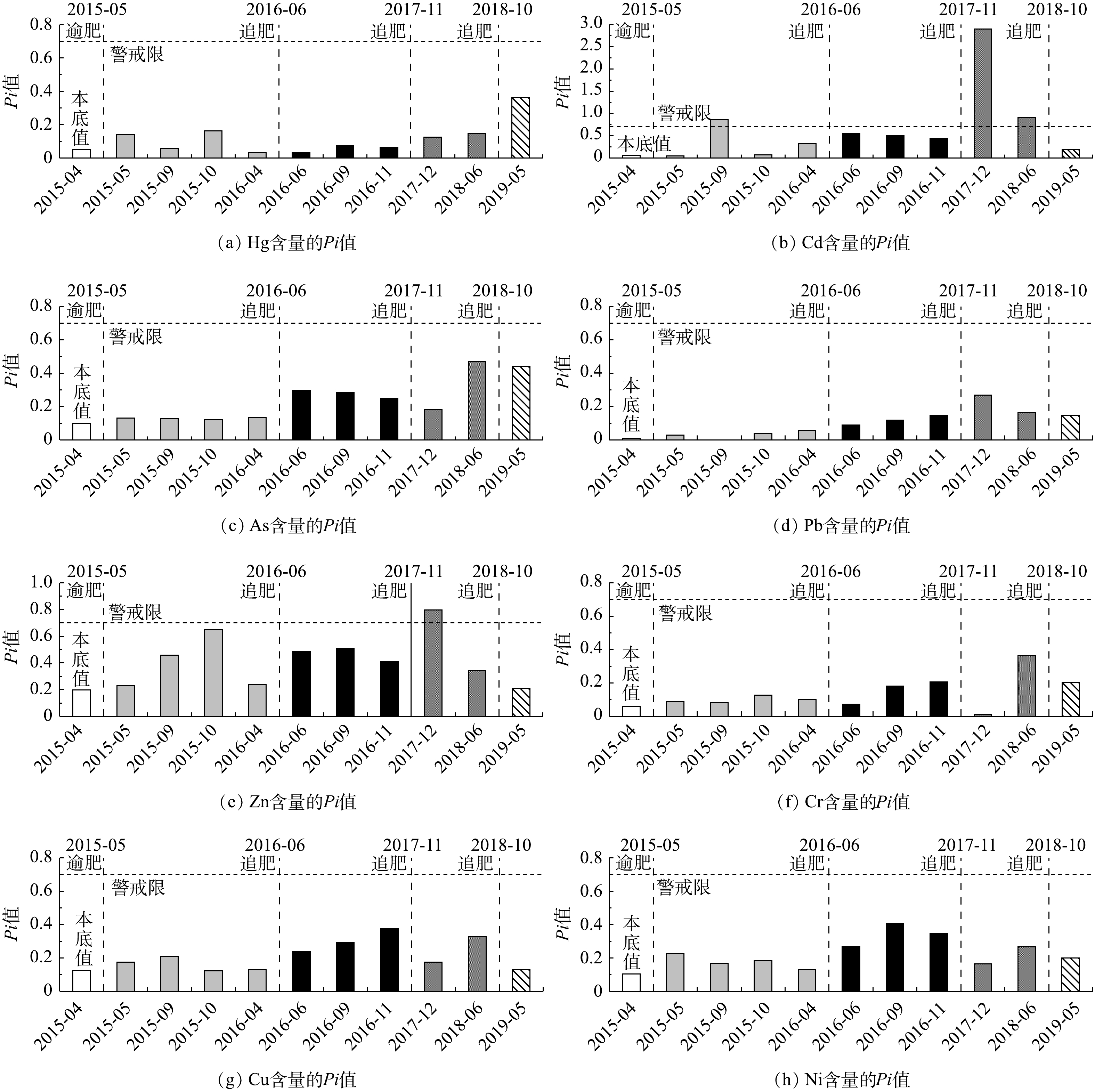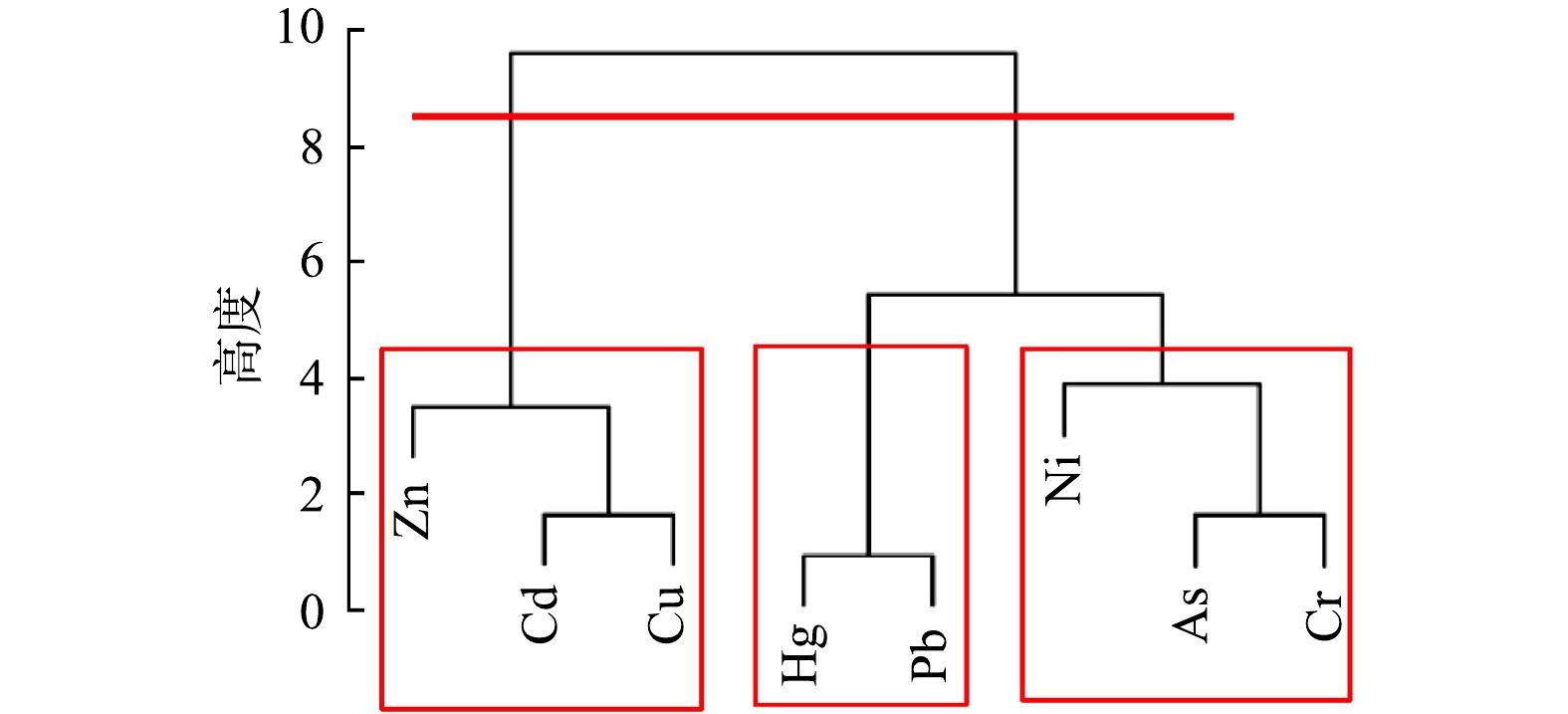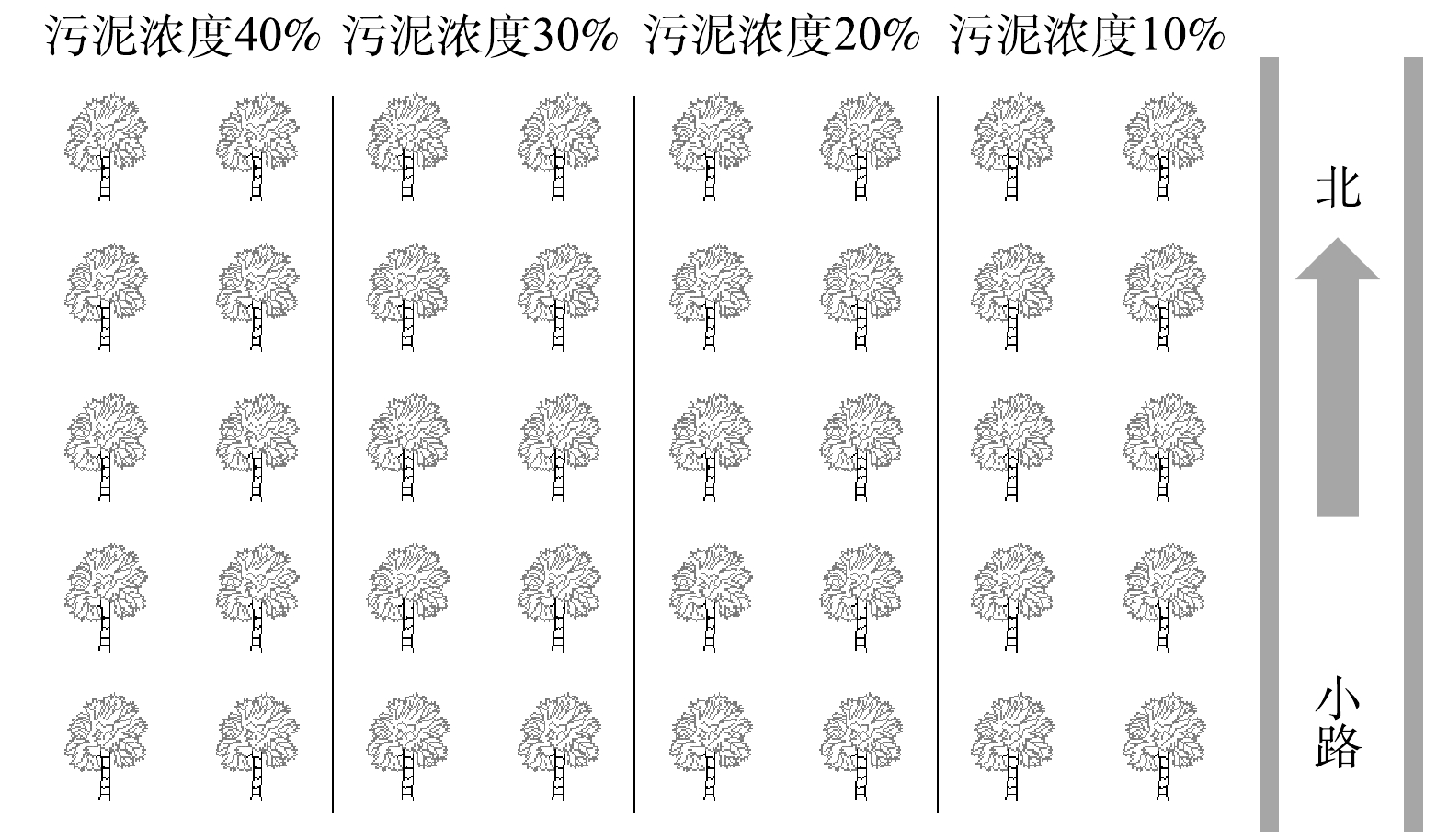-
随着城市污水处理量的大幅度增加,城市污泥产量亦逐年提高,由此带来的城市污泥的处理处置已经成为日益突出的难题。据统计,2020年我国城市污泥产量将突破6.00×107~9.00×107 t[1]。城市污泥的最终处置方式主要为土地利用、焚烧、填埋、建材利用等。其中,污泥林地利用具有诸多优势,可以充分利用污泥中的营养元素及有机质,达到增加土壤肥力、改善植物生长状况等目的[2-3];同时,此处置方式还能避免污泥进入食物链,从而避免对人群健康的影响[4]。但是,城市污泥中存在的重金属是制约其土地利用的主要因素[5-6]。有研究[7]表明,城市污泥中的重金属会以不同的形态存在于土壤环境中。其中,Cu、Cd以及Hg等毒性较强的重金属以残渣态存在,而Zn和Ni主要以不稳定态存在。重金属在土壤中的累积可能导致超标,进而危及到土壤环境安全。因此,污泥产品施用于林地后带来的重金属环境风险问题值得关注。
为评价污泥产品在林地中长期施用可能带来的生态环境风险,本研究连续5年将城市污水处理厂污泥堆肥产品施用于供试林地,结合施肥过程中连续5年监测的土壤重金属(Cu、Zn、Hg、Cr、Cd、Pb、As、Ni等)含量变化数据,分析污泥堆肥泥质、不同的施肥比例以及连续追肥等因素对土壤重金属产生的环境风险影响;并依据数学模型预测多年连续施肥给土壤带来的环境风险,以期为城市污水处理厂污泥的林地利用提供参考。
全文HTML
-
本研究实验区域位于北京市大兴区永定河沙荒地平原造林场地,林地种植的树种主要为白皮松、红花洋槐等具备防风固沙功能的典型树种。白皮松5年的监测数据相较于红花洋槐的监测数据更为全面,因此,以该区域种植的白皮松作为研究树种。采用北京市某城市污水处理厂经过堆肥处理后的污泥堆肥产品(含水率40%)进行林地施肥,施肥方式采用环状沟施,即距树基(滴水线树冠垂直下来到地面的线)40~60 cm处分别挖出深度为20、30、40、50 cm的施肥环沟进行施肥。施用污泥堆肥产品的重金属含量和施肥日期见表1。白皮松林地按照施肥比例分为4个地块,每个地块设置生长条件相同的供试样树10颗;4个地块中施用污泥堆肥产品与表层土壤的掺混质量比分别为10%、20%、30%、40%(如图1所示),以保证施肥比例10%~40%地块中每颗树所施用的干污泥量分别为0.045、0.090、0.135、0.180 t,该施用量符合标准[8]中施用量不应超过30 t·hm−2(以干污泥计)的规定。
-
林地每个地块采用S形布点方式选择3棵样树进行取样,采集后混匀合为1个土壤样品,避免土壤重金属含量的不均质性所带来的分析误差。利用土钻采集0~20 cm深度的土壤样品,装入样品袋。将湿润土壤样品摊成2 cm厚的薄层于阴凉通风处风干,拣出碎石、砂砾及植物残体等杂质;再将风干样品用研磨棒压碎,拣出杂质并用四分法分取压碎样,全部过20目尼龙筛,再过100目尼龙筛后待测。土壤样品按不同污泥堆肥施用比例、不同取样深度进行编号存放。
-
准确称取土壤样品0.1 g,置于溶样杯后,用少量水润湿,在通风橱中逐步缓慢加入4 mL浓盐酸、2 mL浓硝酸、2 mL氢氟酸。样品与消解液充分混匀后移至消解管中,加盖置于微波消解转盘上,采用梯度升温的方法(第1步10 min从室温升温至100 ℃,保持3 min;第2步10 min从100 ℃升温至150 ℃,保持3 min;第3步5 min从150 ℃升温至190 ℃,保持45 min;第4步风冷15 min)进行消解。待管内温度降至室温后从通风橱中取出,缓慢泄压放气,打开消解管盖。将消解后的混合液倒出后,用去离子水清洗消解罐2~3次并收集清洗液,用0.45 μm的聚四氟乙烯膜过滤,收集滤液用去离子水定容至50 mL,于4 ℃下保存待测。其中,Hg含量采用微波消解-原子荧光法进行测定[9-10],Cu、Zn、Cr、Cd、Pb、As、Ni等7种重金属含量采用微波消解-电感耦合等离子体质谱法测定[11-12]。
-
研究区域白皮松林地施用的污泥堆肥采用《城镇污水处理厂污泥处置林用泥质标准》[8]进行评价。自2015年5月至2018年10月每年施肥1次,共施肥4次,至2019年5月共连续监测5次。监测施肥前后林地土壤重金属含量,所得结果参考《土壤环境质量标准 农用地土壤污染风险管控标准(试行)》[13](6.5<pH<7.5)中8种重金属的污染风险筛选值作为参比值。在尚未被污染的林地施肥选择污染风险筛选值作为参比,可提前关注到土壤重金属的潜在风险,一旦超标代表可能存在污染风险,而土壤中污染物低于或者等于风险筛选值时,土壤污染风险则低,一般可忽略。
本研究采用单因子指数法对林地土壤进行环境质量评价,并采用潜在生态危害指数法进一步探究施肥林地土壤中重金属产生的潜在生态风险。单因子评价计算公式[14]见式(1)。
式中:Ci为单项指标i在不同环境介质中的监测数据;Si为单项污染指标i的环境质量标准。
当Pi值大于1时,认为存在一定的环境影响;当Pi值小于1时,认为在该指标方面不存在环境影响;当Pi值介于0.7与1之间时,则认为该指标处于警戒范围。潜在生态危害指数法评价公式[15]见式(2)。计算之后,得到FEI和FRI值,参照风险等级标准(见表2)进行评价。
式中:FRI为综合生态风险指数;FEI为某一重金属的潜在生态风险指数;
Tir 为某一重金属的生物毒性响应系数,据文献[15]可知,Zn=1、Cr=2、Cu=Pb=Ni=5、As=10、Cd=30、Hg=40;Cir 为某一重金属的环境暴露值;Sir 为重金属的参比值,参比标准选用《土壤环境质量标准 农用地 土壤污染风险管控标准(试行)》[13]中土壤污染风险筛选值。本研究采用土壤污染物残留量预测模型。此模型可根据重金属在土壤中的迁移转化规律和土壤的自净能力,通过对重金属的输入量、输出量、残留率和污染趋势的研究来计算施肥后土壤中重金属的残留量,符合研究需求[16-18]。
土壤污染物在土壤中n年内的累积量的计算模式[14]见式(3)。
式中:W为污染物在土壤中年残留量,mg·kg−1;n为污染年限;B为区域土壤背景值,mg·kg−1;E为土壤污染物对单位土壤的年输入量,mg·kg−1;K为土壤污染物的残留率;X为污泥中污染物含量,mg·kg−1;G为耕作层单位土壤质量,kg·m−2;M为每年的污泥施用量,kg·m−2。依照文献[18]可知,盆栽实验所得不同重金属的年残留率为Cu=Pb=Cr=Cd=As=99%、Zn=95%、Hg=86%。
1.1. 实验区域及施肥规划
1.2. 样品采集与预处理
1.3. 样品处理与测定
1.4. 分析方法
-
研究区域连续4年施用的污泥堆肥中重金属含量变化如图2所示,参考的标准为《城镇污水处理厂污泥处置林用泥质标准》[8]。由图2可以看出,8种重金属Cu、Zn、Hg、Cr、Cd、Pb、As、Ni的Pi值均小于1,这表明重金属的含量均未超过《城镇污水处理厂污泥处置林用泥质标准》[8]的标准值。同时,堆肥污泥中重金属含量基本稳定。其中,Hg的Pi值处于0.26~0.52,Pi值小于1,这表明Hg未产生污染。
图3显示了林地施用污泥堆肥产品的重金属潜在风险。可以看出,Hg在8种重金属之间产生的潜在生态风险的贡献率最大,最高可达87.35%;Cd的Pi值为0.06~0.25,其对重金属综合生态风险的贡献率也逐年增加,在2018年高达28%。因此,当污泥施用到林地后,需重点关注Hg和Cd可能带来的污染和风险。此外,Pi值排序为Hg>Zn>Pb>Cu>Cd>As>Cr>Ni,这说明Hg、Zn、Pb的Pi值相对较高;而按照潜在生态风险贡献率排序Hg>Cd>As>Pb>Cu>Zn>Cr>Ni来看,Hg、Cd、As、Pb的潜在风险相对较大,其贡献率分别为75.56%、12.53%、3.60%、3.46%。
-
施用不同比例堆肥污泥后,林地土壤中重金属Pi值变化如图4所示,参考标准为《土壤环境质量标准 农用地 土壤污染风险管控标准(试行)》[13](6.5≤pH<7.5)。由图4可以看出,施肥之后土壤中8种重金属的Pi值基本都高于本底值。这说明污泥堆肥产品的施用会导致土壤中重金属含量的增加。但是,8种重金属的Pi均小于1,这表明首次施肥后的1年内重金属的含量均未超标,符合土壤环境质量标准的要求。值得注意的是,Cd和Zn的含量超过了警戒限,这表明堆肥污泥的施用对土壤中Cd、Zn含量影响较大,可能会产生风险。由2015年5月与2016年4月的监测结果中可以看出,土壤中重金属含量随着施肥比例的增加而递增,2015年5月Cd含量增长最为明显。在4种施肥比例下,Cd的Pi值分别为0.047、0.357、0.643、0.997,虽未造成污染,但Cd的Pi值在40%的污泥施用比例下已接近1,可能会产生污染风险。4次监测结果表明,施用污泥比例较高(30%和40%)的地块,重金属Pi值均较高,即可能会产生风险。此外,在8种重金属中,Hg、Zn、Cd的Pi值相对较高,最高值分别达到了0.505、0.898、0.996。
为进一步确认土壤中重金属的潜在风险,对首次施肥的土壤进行了潜在生态风险评价,结果如图5所示。由图5可知,各重金属的综合生态风险指数RI值均远小于150,EI值均小于40,这表明首次施用污泥堆肥产品后,土壤重金属处于低风险阶段;而施肥地块RI值均高于土壤本底RI值,这表明污泥的施用会导致土壤中重金属的累积。与图4所反映出的规律相似,在刚施肥和施肥1年后,重金属潜在生态风险随着污泥施用比例的增加而增加,在施用比例为30%和40%的地块中,重金属综合生态风险相对较大,其RI最大值分别为38.31、56.39;而施肥比例为10%和20%的地块中最大RI值分别为32.24和22.16。此外,在土壤本底值中,Cd的潜在风险贡献为25.25%,而在施肥后Cd的潜在风险贡献率高达80.94%,Hg的贡献率从33.10%增长至68.33%。这表明在污泥施用前后,Hg、Cd产生的风险变化较大。本研究获得的结果与谌思嘉[18]的研究结果相符,均表明污泥林地利用过程中Hg、Cd属于具备极高生态风险的重金属。综上所述,当施肥比例为10%和20%时,重金属的潜在风险相对较低,可以进行连续施肥;而施肥比例为30%和40%时,重金属的潜在风险较大,不宜继续连续施肥。
-
图6为连续5年施用10%配比污泥林地的重金属Pi值变化图。由图6(b)可知,Cd的Pi值在2017年12月超过了1;8种重金属的Pi<1,满足标准要求。但Cd和Zn在2017年和2018年均出现Pi值大于0.7,超过警戒限,这表明堆肥污泥的施用对土壤中Cd和Zn含量影响较大。此外,从长期来看,重金属Pi值基本全部大于本底Pi值,且重金属含量呈现递增趋势。这表明污泥的施用确实是土壤中重金属累积的重要原因之一。堆肥污泥的施用虽然并未使得重金属含量超标,但从图6中可以发现,Cd、As、Hg、Zn的Pi值较高,需进一步评价这些重金属存在的潜在生态风险。
8种重金属的综合风险RI值随时间变化如图7所示。从图7中可以看出,8种重金属潜在生态风险指数EI<40、综合生态风险指数RI<150,表明其处于低风险阶段;但从连续5年的监测结果可以看出,风险总体呈现增加趋势,这表明重金属在表层土壤中产生了累积,但仍处于低风险范围。综合生态风险在施肥当年呈现先增后减的趋势(如2015年5月—2016年4月),这可能是由于降水导致重金属向外迁移所致。由于施肥方式采用环状施肥,重金属向外迁移的范围较小,故本研究中监测到施肥环内外和不同深度(0~60 cm)土层土壤中各重金属含量均未超标。但Cd的风险相对较高,在施肥比例为10%的地块中,深度为40 cm的施肥环内与环外Cd的含量分别为0.221和0.207 mg·kg−1,60 cm的施肥环内与环外分别为0.207和0.290 mg·kg−1,接近于标准值[13],因此,需重点防范Cd可能带来的风险。此外,虽然每年采样时间不同,但重金属的综合生态风险在年内呈现先增后减的趋势,因此,每年取样时间的不同对研究的影响较小。8种重金属潜在风险贡献率的顺序为Cd>Hg>As>Ni>Cu>Zn>Pb>Cr。其中,Cd、Hg、As的贡献率相对较大,平均可达50.74%、22.09%、10.41%。堆肥污泥施用后Cd的贡献率从未使用污泥前的25.25%增加到了施肥后的89.07%。这表明施肥对重金属中Cd含量的影响很大,施肥后土壤中Cd可能产生风险。
-
以林地土壤重金属本底值为背景值,采用土壤污染物累积模型对施肥比例为10%的林地土壤中重金属含量随施用年限的累积情况进行预测。施肥第1年至第4年采用实际污泥堆肥泥质预测重金属含量,而后采用其中含量最高1年的重金属进行预测,结果如表3所示。由表3可以看出,在连续施用堆肥污泥产品11年后,土壤中Zn和Cd的含量超过了2018年发布的《土壤环境质量标准 农用地土壤污染风险管控标准(试行)》[12](6.5<pH<7.5)。这表明,在这种施肥条件下可能存在污染风险,此时应立即停止施肥,并加强土壤环境监测,探究污染原因,采取相应措施。由此可知,施肥比例为10%配比污泥在10年之内风险较小。预测值与施肥开始的前4年实测值对比发现,Cu、As、Hg、Cr等4种重金属预测值与实测值相近或略低,但Zn、Cd、Ni、Pb等4种重金属的实测值均高于预测值。研究区域中除施肥外,其他人类活动较少,推测Zn、Cd、Ni、Pb这4种重金属除受施肥影响之外,大气沉降、降水以及土壤介质的不均匀等因素也是影响其含量变化的因素之一。因此,对于其来源需进行进一步相关分析。
-
为探究施肥林地土壤中的重金属是否全部来源于施肥污泥,对土壤中各重金属含量进行了相关分析(方差齐性时(P>0.05),采用Pearson积差相关系数;方差非齐性时,采用Spearman秩相关系数),结果见表4。
施肥林地土壤中重金属的来源之间具有显著相关性。根据表4可以看出,As与Cr之间,Cd与Zn、Cu之间,Hg与Pb之间重金属含量显著相关,表明其来源相似。值得注意的是,Ni与Cd、Cu、Pb、Hg 4种重金属之间,Cr与Cd、Cu 2种重金属之间,As与Cu之间,Cd与Pb之间呈负相关性;其他重金属之间呈现正相关,表明Ni、Cr、As与Cd、Cu、Pb、Hg来源差异极大,其中Cd与Pb之间的来源也具有较大差异。而Hg与其他重金属之间无显著相关性,这表明Hg与其他重金属的来源差异较大。其主要原因是:由于林地土壤黏性较差,孔隙度大,Hg易释放到空气中所致[19]。
污泥堆肥的连续施用是导致表层土壤中重金属累积的重要因素之一,但不排除其他因素也会对表层土壤重金属产生影响。因此,利用表8中相关系数对表层土壤中重金属进行聚类分析,结果如图8所示。由图8可以看出,Hg与Pb的聚类显示距离最短,而相关分析结果也显示Hg与Pb呈显著正相关,故可以表明,林地施肥后,Hg与Pb的含量来源是极其相似的。同样,Cd、Cu、Zn的聚类显示距离较短,Ni、As、Cr的聚类显示距离也相对较短。因此,根据聚类分析树状图将土壤重金属分为3类:第1类是Zn、Cd、Cu;第2类是Hg、Pb;第3类是Ni、As、Cr。该结果表明,Zn、Cd、Cu之间,Hg、Pb之间,Ni、As、Cr之间重金属的来源是具有相似性的。有研究[20-21]发现,国内土壤中Zn、Cd、Cu主要来自于施肥等农业活动,部分地区还来源于工业活动,甚至以后者为主;Hg则主要来源于工业活动及其产生的大气沉降,局部地区叠加高Hg农药的贡献;Pb的来源则比较复杂,主要来自工业、交通和垃圾堆肥等;As、Cr、Ni则主要受土壤母质控制。根据本研究对林地施肥土壤重金属的相关性和聚类分析,可推测林地土壤中重金属的来源包括:Ni、As、Cr的含量主要受土壤母质的影响,并叠加施肥的影响;而Hg、Pb则主要是受到污泥施用、大气沉降等多因素作用的共同影响;Zn、Cd、Cu在污泥中含量相对较高,且林地受人为影响较小,故Zn、Cd、Cu在土壤中的含量主要是受到施肥的影响。
2.1. 林地施用污泥堆肥产品泥质分析
2.2. 不同施肥比例地块中的重金属风险评价
2.3. 林地连续施肥地块重金属风险评价
2.4. 连续施肥后林地土壤中重金属含量预测结果及风险分析
2.5. 林地土壤中重金属含量间的相关性
-
1)对污泥堆肥产品泥质分析发现,污泥中Hg、Cd、Zn、As、Pb可能存在污染风险。
2)施肥比例为10%和20%时产生的潜在生态风险较低,可进行连续施肥;而施肥比例为30%和40%时产生的潜在生态风险较大,不宜连续施肥。
3)连续5年施肥,林地土壤中除Cd在2017年12月超标外,其余重金属均未超标,但重金属含量呈累积趋势。经模型预测,在施肥比例为10%的林地土壤中,连续施用10年是安全的。
4)对重金属进行的相关分析及聚类分析结果表明,林地土壤中重金属的来源并非全部源于施肥污泥。土壤中Zn、Cd、Cu含量主要受施肥影响,Hg和Pb受施肥以及大气沉降等综合作用影响,而Cr、Ni、As主要来源于土壤母质。





 DownLoad:
DownLoad:

